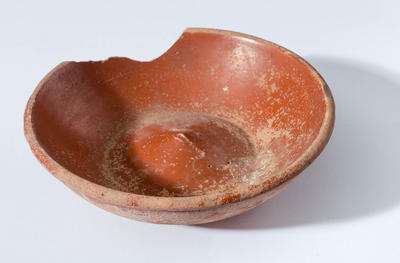Vessel, bowl, Samian Ware, from the potter Aestivus
Production date
155 CE-195 CE
Country
England
See full details
Object detail
Description
Plain Samian Ware pottery bowl with Aestivus stamped in centre. Gaulish slip ware. Bowl incomplete, with large fragment removed from approximately one quarter of one section of the rim, and erosion to the slip on the bowls outer surface, possibly resulting from its immersion in the River Thames.
Classification
DOMESTIC EQUIPMENT Food and Drink Consumption bowl
ARCHAEOLOGY Roman
ARCHAEOLOGY Roman
Production date
155 CE-195 CE
Production place
Measurements
H60mm x W187mm x D187mm
Media/Materials description
Pottery vessel made of fired clay, complete or fragmented
Inclusions to make the clay less sticky, reduce shrinkage, increase resistance to thermal shock and strength prior to firing.
Gloss (gloss is produced by dipping the vessel into a slip with a high proportion of very fine clay particles. The difference between a slip and a gloss is that a slip is applied to give a different colour, and a gloss is applied to give a sheen to the surface).
Inclusions to make the clay less sticky, reduce shrinkage, increase resistance to thermal shock and strength prior to firing.
Gloss (gloss is produced by dipping the vessel into a slip with a high proportion of very fine clay particles. The difference between a slip and a gloss is that a slip is applied to give a different colour, and a gloss is applied to give a sheen to the surface).
Signature/Marks
Aestivus
History and use
Red-slip Roman pottery was found on tables thoughout the Mediterranean, following its mass-production from the 3rd C BCE. It was imported from major workshops in Italy, France, and North Africa, which was then part of the Roman Empire. Plain, undecorated vessels were common and stamped in the base of the bowl with the name of the maker or workshop. This plain red ware pottery bowl has the workshop stamp of Aestivus in the bowls centre. Aestivus was a potter working in Gaul (Lezoux, France) between AD155-195. Their material is known across the whole ancient Mediterranean. This bowl was allegedly found during dredging at the mouth of the River Thames.
Associated person
Registration number
H734



